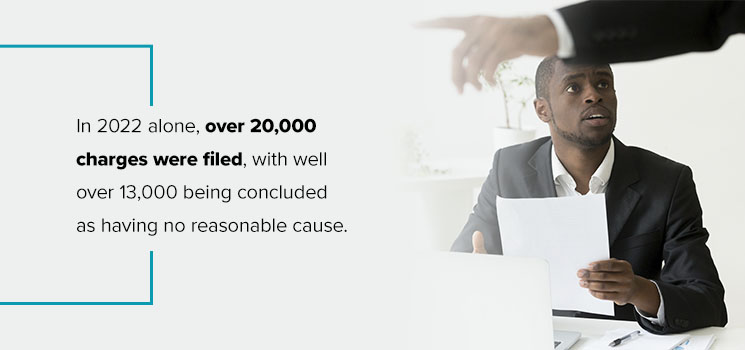By Weisberg Cummings, P.C. on August 24th, 2023
There are three things you should consider when suing for racial discrimination. First is the law because it helps determine whether you have a cause of action or legal claim. Second is the procedure, which includes the pre-conditions for commencing legal proceedings, the court with jurisdiction to hear your case, and the relevant documents you will need. Third is evidence, which is necessary to substantiate your claim. While an employment attorney is optional, partnering with one is crucial because you may need their experience conducting the case.
What Qualifies as Racial Discrimination?
Racial discrimination in the workplace includes an adverse employment-related action taken against a person because of their race. Racial discrimination in the workplace can include:
- Refusing to hire a qualified candidate because of their race.
- Denying an employee a well-deserved promotion because of their race.
- Refusing to provide training for employees due to their racial background.
- Arbitrarily terminating an employment contract based on race.
- Denying an employee pay or benefits because of their race.
- Segregating or classifying employees based on their racial background.
The list goes on.
Racial discrimination can impact a person’s performance at work, as well as their personal lives. It can cause those affected to lose belief in their abilities, result in psychological problems such as depression and anxiety, and impact their financials. That is why it is necessary to understand the various racial discrimination laws to protect your rights.
The Laws to Consider When Filing a Racial Discrimination Lawsuit
Before you sue for racial discrimination, it is best to assess the laws and understand the protection each offers. Examining the law also lets you determine whether you have a cause of action or legal claim against your employer. In terms of legislation, you may rely on federal or state laws. Here are two examples:
1. Title VII of the Civil Rights Act
The landmark piece of federal legislation passed in 1964 prohibits many forms of workplace discrimination, including discrimination based on race. Generally, the law applies to employers with at least 15 employees, although other requirements must be met. Under Title VII, employers must not take adverse actions or retaliate against an employee because they complained about discrimination at work, filed a discrimination charge against the employer or their subordinates, or participated in any investigation or lawsuit involving discrimination.
The law also makes it illegal for employers to implement discriminatory policies and practices against a racial group or individual. When the employer harasses the employee because of race, the employee can file a complaint for redress.
2. The Pennsylvania Human Relation Act (PHRA)
This state law prohibits employers, labor organizations, employment agencies and others from discriminating against prospective, current and past employees based on race. The Pennsylvania Human Relations Commission (PHRC) enforces the PHRA, which includes accepting complaints, investigating the allegations and taking remedial action.
The Evidence You Need to File a Racial Employment Discrimination Lawsuit
Racial discrimination is a serious allegation, so you must gather credible evidence when lodging a complaint or filing a lawsuit. In 2022 alone, over 20,000 charges were filed, with well over 13,000 being concluded as having no reasonable cause. Therefore, in addition to assessing the law, gather solid evidence to build a formidable case. There are different types of evidence you may use to prove your case, often categorized into the following:
1. Direct Evidence
Direct evidence is any evidence that directly proves a fact. Within the context of racial discrimination, the employer or someone acting on their authority may make a statement or a decision with a clear racial motive.
The employer may express the statement in many forms, such as emails, text messages, letters, recordings or the employment contract. Testimonies from witnesses about the employer’s racial comments or decisions may also qualify as direct evidence. Finding direct evidence can be rare, making indirect evidence crucial.
2. Indirect Evidence
Indirect or circumstantial evidence establishes racial discrimination based on inferences. In other words, it is evidence of another fact that leads to the conclusion that the defendant is liable. It’s like putting pieces of a puzzle together to get a clear picture. For example, the employee may provide statistical information combined with the employer’s prior inappropriate remarks, making racial discrimination the more probable explanation for the action or decision.
How to File a Racial Discrimination Complaint
Filing a racial discrimination complaint is often a pre-condition to commencing legal action. However, the employee may resort to the complaint procedure without going to court. While many avenues exist for filing complaints, the processes are similar. They typically involve these steps:
- Within 180 days, you file a complaint with the agency by telephone, email, mail or in person at their office.
- The agency reviews your complaint, asks you to complete a questionnaire and consults your employer.
- Next, an investigation is conducted to determine whether you have a claim.
- If the agency determines your claims are valid, they may negotiate with your employer to find a resolution.
- Otherwise, they will institute legal action against your employer or issue a Notice of Right to Sue, which allows you to commence a civil action.
The Equal Employment Opportunity Commission (EEOC) is the primary federal agency that enforces employment discrimination laws in the United States. In Pennsylvania, you may file a complaint with the PHRC and request dual filing with the EEOC. Employees who work for employers doing business with the federal government may file a complaint with the Office of Federal Contract Compliance Programs (OFCCP). Finally, employees related to the U.S. Department of Health and Human Services (HHS) may file a complaint with the Office for Civil Rights (OCR).
In addition to protection under Title VII and the PHRA, 42 U.S.C. §1981 (Section 1981) also creates a federal cause of action for individuals claiming intentional racial discrimination. And, unlike Title VII and the PHRA, Section 1981 has no minimum limit on the number of employees, no caps on damages, and does not require filing in the EEOC or PHRC. Section 1981 has a 4 year statute of limitations.
How to File a Racial Discrimination Lawsuit
Here is how you can sue a company for racial profiling:
1. Collect Evidence and Documentation
Gather every document to help you prove your case and keep them safe. Talk to potential witnesses and inform them about your intention to sue to ensure they are available when needed.
2. File a Charge
File a racial charge with the appropriate state agency and secure the Notice of Right to Sue. That gives you the authority to commence legal proceedings.
3. Draft and File Your Complaint in Court
Filing a complaint in court initiates the lawsuit. Ensure the court has jurisdiction to entertain the matter and serve the defendant with the necessary processes. Your employer may also file a defense in response to the allegations.
4. Start the Discovery Process
The discovery stage involves exchanging evidence and other relevant information. Discoveries typically begin after pleadings have been filed. Dispositions and interrogatories are also generally conducted at this stage.
5. Proceed to Trial
The matter will proceed to trial unless the parties agree to settle out of court. At trial, parties can cross-examine each other’s witnesses and adduce evidence supporting the claim. Ultimately, the court will assess the evidence according to the law, make a determination and give the necessary orders.
Why Do You Need an Attorney to File a Lawsuit for Racial Discrimination?
Partnering with an attorney is optional but often necessary, especially in racial discrimination cases that can prove challenging. Lawyers have a good understanding of both the substantive and procedural aspects of the law. They can also assess your evidence to determine the possible outcomes and strategize to achieve the best results. Additionally, racial discrimination complaints and lawsuits can be physically and emotionally draining, so getting support from a reliable attorney can take the load off your shoulders.
Contact Weisberg Cummings for Legal Assistance
It is one thing to start a racial discrimination lawsuit and another to achieve the desirable results. Therefore, you should partner with an experienced attorney to increase your chances of success. Weisberg Cummings is an employment law firm with over 40 years of combined experience in workplace discrimination. We offer practical legal solutions by taking the time to understand your concerns. Do you need urgent legal assistance? Contact us today.



